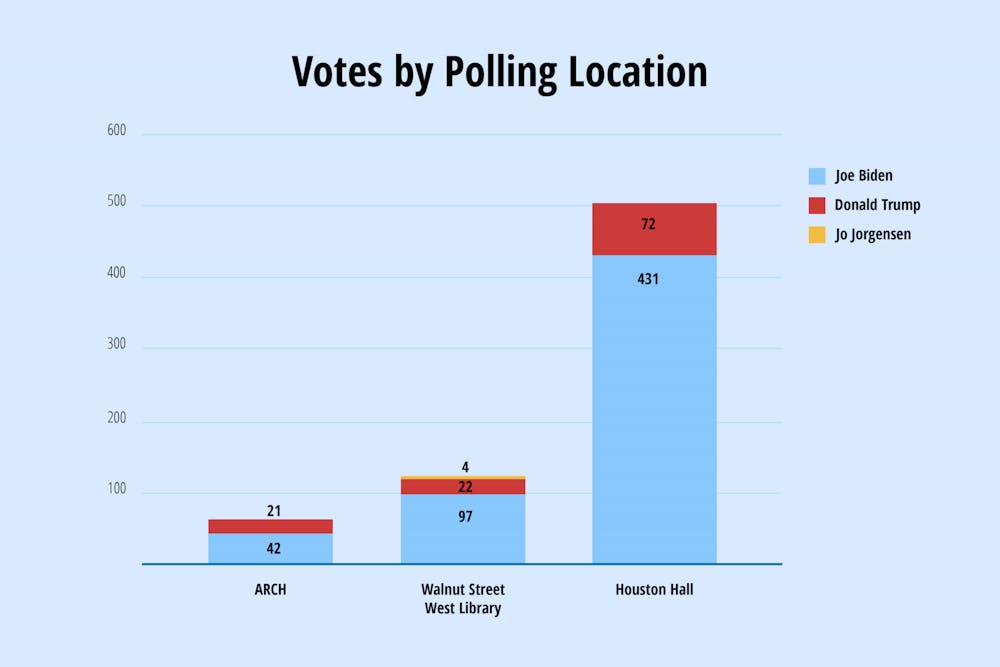
503 votes were cast at Houston Hall, one of three polling locations on Penn's campus.
Credit: Chase SuttonAs the sun rises on Nov. 4, the presidential election remains too close to call.
All eyes now turn to Pennsylvania, a key battleground state, as President and 1968 Wharton graduate Donald Trump and former Vice President Joe Biden remain neck and neck while the state scrambles to count votes throughout the night.
Pennsylvania, with 20 electoral votes, will be a key decider in calling this election, as Trump flipped the state and won by less than 1% in 2016.
Although Penn's campus remains largely shuttered amid the remote semester, members of the Penn and local Philadelphia community turned out at the three polling locations on campus: Houston Hall, the ARCH Building, and the Walnut Street West Library.
A total of 689 ballots, not including dropped off mail-in ballots, were cast in-person on Election Day, according to election judges at the three polling sites. Eighty-three percent of ballots were cast for Biden, a former Penn Presidential Professor of Practice — down from 91% of ballots received for former Secretary of State and 2016 Democratic nominee Hillary Clinton.

In the 2016 presidential election, approximately 4,000 ballots were cast on Penn’s campus across six on-campus voting sites.
Among the three polling sites open this year for students living on or near campus, Houston Hall saw the most turnout with a total of 503 votes, 86% of which were cast for Biden. ARCH and Walnut Street West Library reported 67% and 79% of votes, respectively, for the Democratic nominee. Out of the 689 ballots cast on campus, four were for Libertarian nominee Jo Jorgensen and 115 were for Trump.
Election Day on campus began with long lines at Houston Hall, totaling approximately 200 people at around 8 a.m. By around 9:30 a.m., voter lines had dissipated and at virtually no point during the day was the wait over 10 minutes.
Judge of Elections Daniel Flaumenhaft, who has served as judge at ARCH for the past 12 years, said most ARCH votes were cast within the first 30 minutes after the polls opened at 7 a.m. Dawn Deitch, executive director of the Office of Government and Community Affairs and coordinator of Penn polling places, said Houston Hall also experienced an early rush of voters.
Philadelphia voter turnout, likewise, surged in the early morning with long lines across the city and in local suburbs, according to The Philadelphia Inquirer. A poll worker for the 5th division of West Philadelphia’s 27th Ward told the Inquirer that the higher amount of mail-in ballots this year, as opposed to traditional in person voting, is largely due to the fact that college students currently living away from campus still chose to vote in Pennsylvania.

Polling sites in Pennsylvania did not close until 8 p.m. but Penn’s three voting sites were quiet in the final hours. Houston Hall reported at 6 p.m. that 501 ballots had already been cast, two away from its final count.
Penn President Amy Gutmann and her husband were two of the 503 voters at Houston Hall on Tuesday. Before she voted, she spoke with The Daily Pennsylvanian about the importance of voting, particularly in the current political and social climate.
"Every election is incredibly important, but this election, given the pandemic, given the fight against racism, given that Philadelphia is the birthplace of freedom and justice, all of our students, members of the Penn community, and everyone across America should be voting in this election," Gutmann said.
As predicted, Pennsylvania’s early voting returns show that Democrats are much more likely to vote by mail than Republican, skewing Tuesday's initial results in favor of Trump. State officials have said they expect most votes to be counted by Friday.
The Daily Pennsylvanian is an independent, student-run newspaper. Please consider making a donation to support the coverage that shapes the University. Your generosity ensures a future of strong journalism at Penn.
Donate







